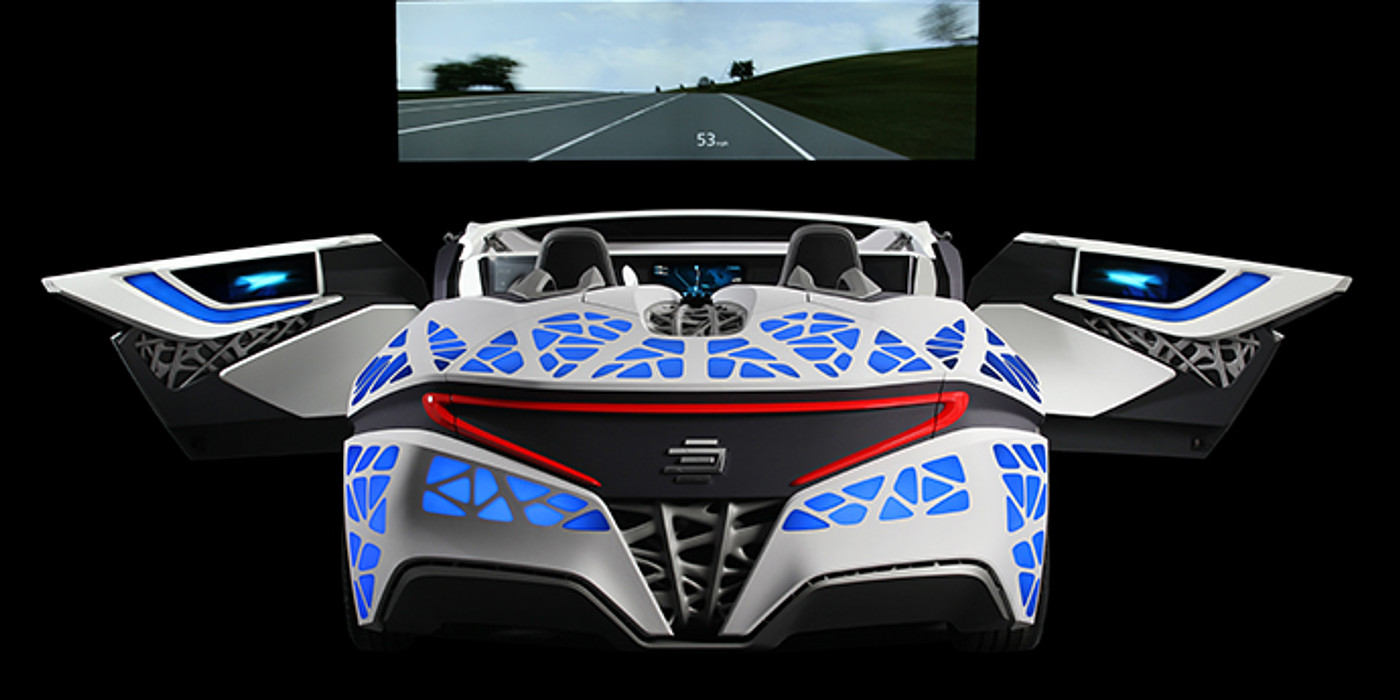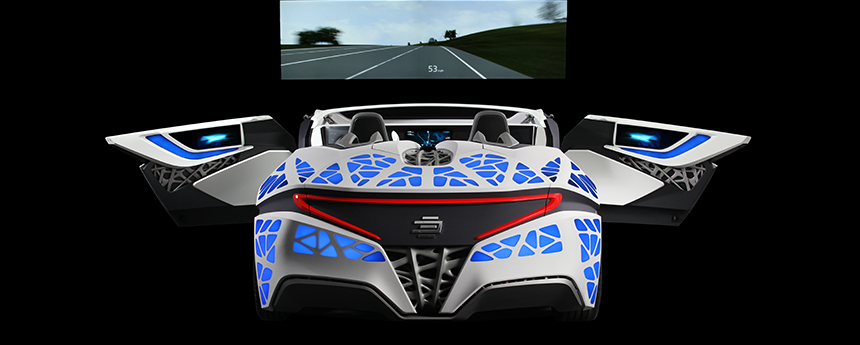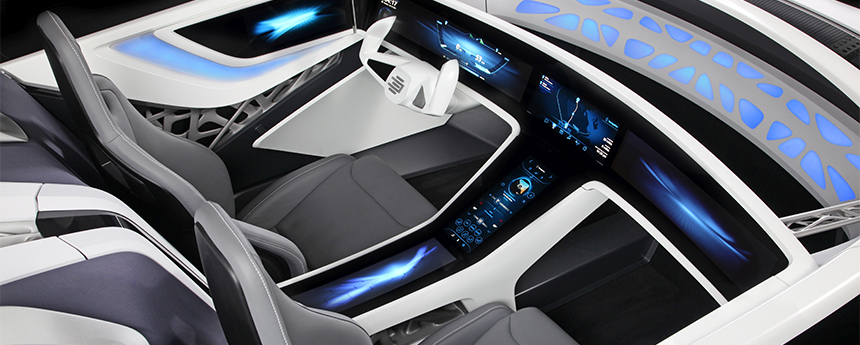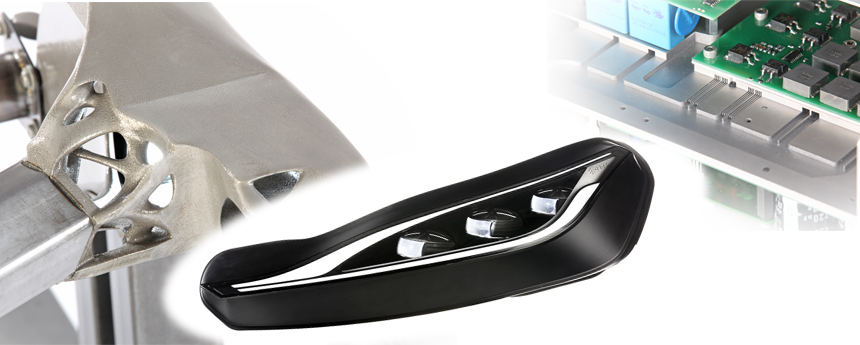The two companies worked together on a joint project to develop the EDAG "Soulmate" – a concept car that demonstrates how networking digital data from the outside world with the vehicle will help to make driving safer and more comfortable in the future. "Soulmate" will also be demonstrating how easily and intuitively these systems can be operated by means of innovative visual and gesture controls, for instance, to keep driver distractions to a minimum. EDAG and Bosch will also be offering a live, hands-on preview of automated driving and smart vehicle connectivity at the Geneva Motor Show.
The external appearance of EDAG's current concept car is just as unconventional as its visionary interior, and breaks with all existing restrictions. The "Soulmate" body concept is EDAG's appeal for a new form of lightweight automobile design, as it uses revolutionary technologies from the field of "3D printing" or additive manufacturing. In Geneva, EDAG will be demonstrating concrete examples of how additively manufactured components could, in the near future, find their way into automotive volume production.
When the car becomes the driver's personal companion
At the 2016 Geneva Motor Show, Bosch and EDAG will be giving an idea of what the future of automotive production might hold. The "Soulmate" will enable visitors to experience a new kind of interaction between humans and technology. The dashboard and central console in the "Soulmate" have been united in an electronic display.
Its contents adapt, for example, to the vehicle's current environment. But the driver's calendar and his personal preferences are also taken into account. And should an appointment be cancelled, the vehicle automatically adjusts the route – to a road where automated driving is allowed, for instance, to give the driver more free time. But this is just one of many applications planned by Bosch, in which the vehicle actively takes care of its driver.
The bionic, fabric-covered structure enabled the EDAG engineers to illuminate the interior and exterior surfaces. This means that "Soulmate" can communicate intelligently not only with the driver, but also with the outside world. The luminous outer skin, for instance, can alert other road users to a possible hazard ahead, the end of a traffic jam, for example. If there is a cyclist or some other vehicle in the vehicle's blind spot, "Soulmate" illuminates the interior trim of the relevant door so that it flashes in red, to alert the driver to the danger. An innovative, simple and at the same time emotional interpretation of car-to-car communication.
Thanks to the Bosch system, the driver is in constant contact with his smart home via the "Internet of Things". If, for instance, a deliveryman comes to the door, the driver simply touches the display in the car to let him into a protected area of the house and acknowledge receipt of the delivery. This shows how easy, versatile and safe interaction with the technology can be. The networked infotainment navigates the driver not just through the traffic, but also through the tasks of the entire day. Soulmate permits fully integrated access to online services and smartphone apps. To ensure that operation is safe and as free of distractions as possible, "Soulmate" is controlled by gestures and visual means.
In addition, Bosch have installed the "neoSense" haptic display in the vehicle, a touch screen that gives the driver the feeling that he is using mechanical buttons. This device can generate different surface textures, allowing elements to be felt on the display. This haptic feedback makes it easier to operate infotainment applications such as navigation, radio, and smartphone functions. Often drivers will not even need to look at the information on the screen to control it.
Instead, they can keep their eyes on the road. The screen generates the feel of rough, smooth, and patterned surfaces to indicate different buttons and functions; to make a selection, a button needs to be pressed more firmly. What makes this special is that the touch screen looks no different from an ordinary display – and yet it gives users the impression that they are pressing real buttons.
Greater safety, freedom and and more time – highly automated driving
Highly automated driving will further increase the safety of road traffic. This will be possible on motorways as of 2020. According to forecasts made by Bosch accident researchers, increasing automation will be able to significantly reduce accident numbers – by up to a third in Germany alone. Bosch will be showcasing the systems and sensors necessary for automated journeys in the EDAG Soulmate. Visitors will also learn how the highway pilot - a highly automated system that assumes all the driver’s tasks and responsibilities on motorways - works. This technology is already being tested on public roads. In the future, cars will also be able to see around bends and be aware of possible danger spots, thanks to a stream of real-time information from the internet on the location of traffic jams, construction sites and accidents. This data will serve as an electronic “connected horizon” and give cars an even better picture of what lies ahead – further increasing safety and efficiency.
Additively manufactured components for the ultimate in future lightweight construction
The exterior of the "Soulmate" is just as innovative as its interior. Like that of its predecessor, the body of the roadster is made up of a bionically inspired skeleton structure covered with a fabric outer skin. With the chances afforded by additive manufacturing, it is now, for the first time ever, possible to create such complex structures. A technology which, on account of tool-free production, will in the future carry extremely interesting economic potential and at the same time offer extremely variable production possibilities," explains Jörg Ohlsen, CEO of EDAG Engineering GmbH. Working on the basis of the vision of a fully additively manufactured body structure, EDAG developed concrete applications which demonstrate how this new production technology might be used in volume production in the near future.
The EDAG engineers will be displaying an example of a hybrid spaceframe concept at Geneva. Its charm lies in the combination of additively produced body parts and conventionally manufactured sections. Thanks to additive manufacturing, these nodes can be highly flexible and multifunctional, so that, for instance, a number of different vehicle variants to be produced using almost no tools. Conventional steel or aluminium sections serve as connecting elements for the structure. This extremely flexible and stable spaceframe structure is an attractive solution that will enable the wide variety of derivatives, variants and drive concepts to be managed economically in the future.
A second example of the close-to-production use of additive manufacturing being shown by EDAG at Geneva is a hybrid housing for an electric vehicle's on-board charger, which weighs 50 % less than a conventionally cast component. At the core of the housing is an ultra-light cooling structure produced using the selective laser melting method with its unprecedented cooling capacity. Due to its compact dimensions, it is already possible for the component to be additively manufactured in large quantities.
The third showpiece will be a fully functional, ready-for-approval model of a headlight, by means of which EDAG intends to demonstrate that it is already possible for additive manufacturing methods to be implemented in low-volume production.
With the presentation of the EDAG Soulmate and close-to-production concepts for additively manufactured components, EDAG underscores its competencies in the development of future technologies for the mobility of tomorrow. "In addition to our expertise in the development of complete vehicles and production plants, we are also continually strengthening our involvement in forward-looking subjects such as connectivity and lightweight design," explained Jörg Ohlsen, EDAG CEO. "In the past year, for example, we have set up a new team that works under our brand name "trive.me" to develop concrete software solutions and products for toe networked mobility of tomorrow." An "end2end" navigation system is currently being developed, for instance. The "trive.park" product will help to relieve motorists of the tiresome task of finding somewhere to park in the city – from reserving a parking space via the navigation inside a multi-storey car park, through to paying the parking fee.
With the company's appearance at the Geneva Motor Show, EDAG will be underscoring its ideals and aims: the ability to think out of the box, to identify and develop new technologies and to gradually transfer them to ready-for-production concepts.



